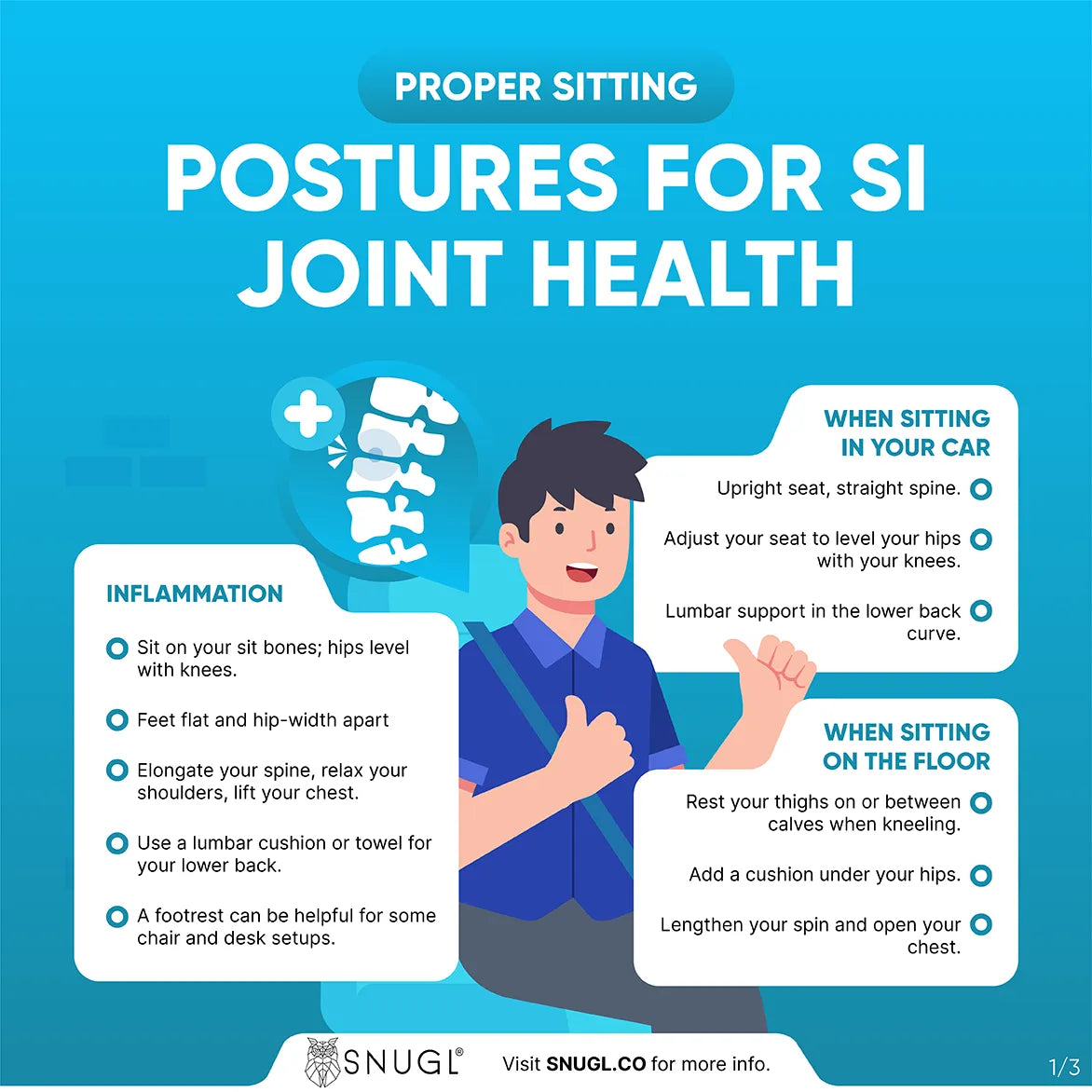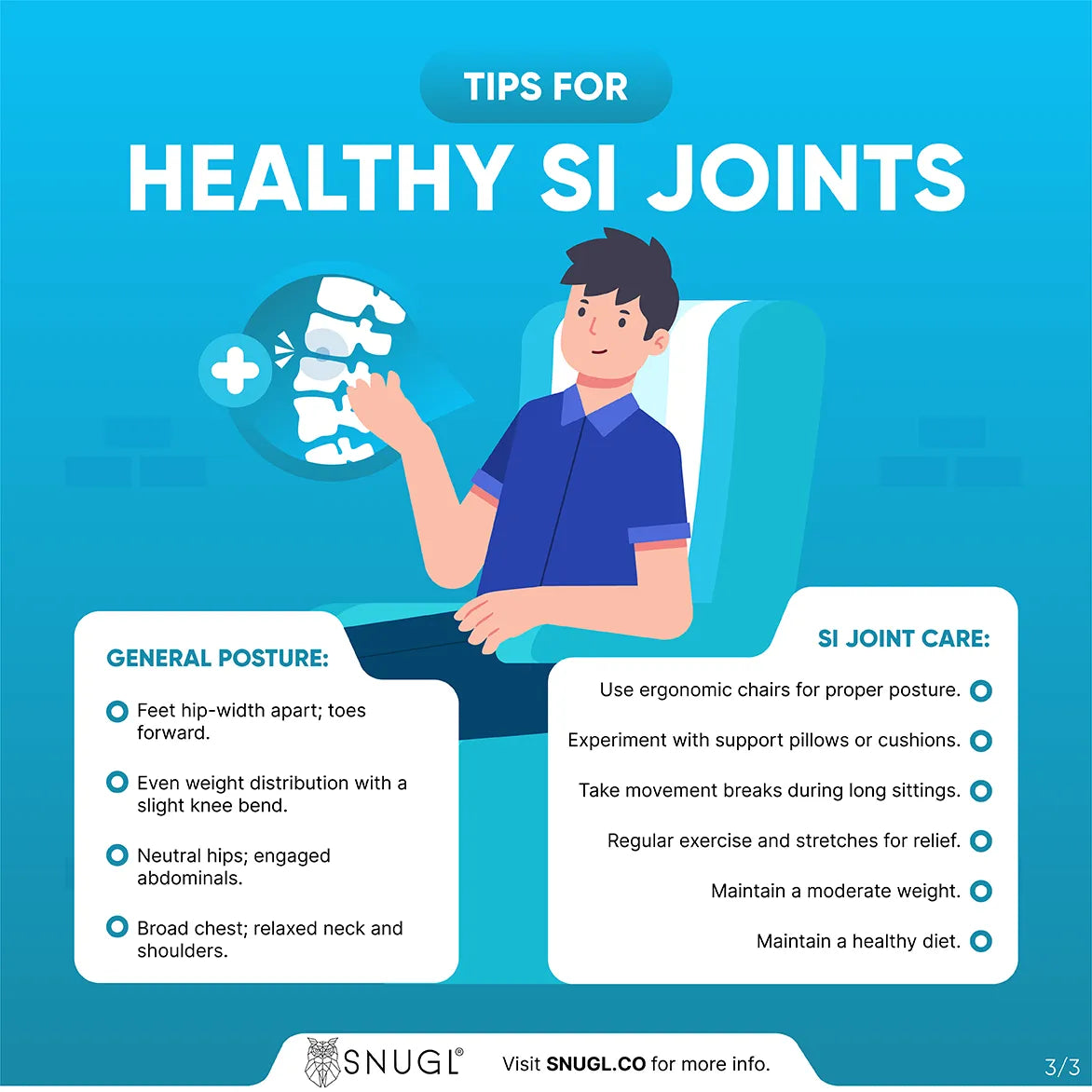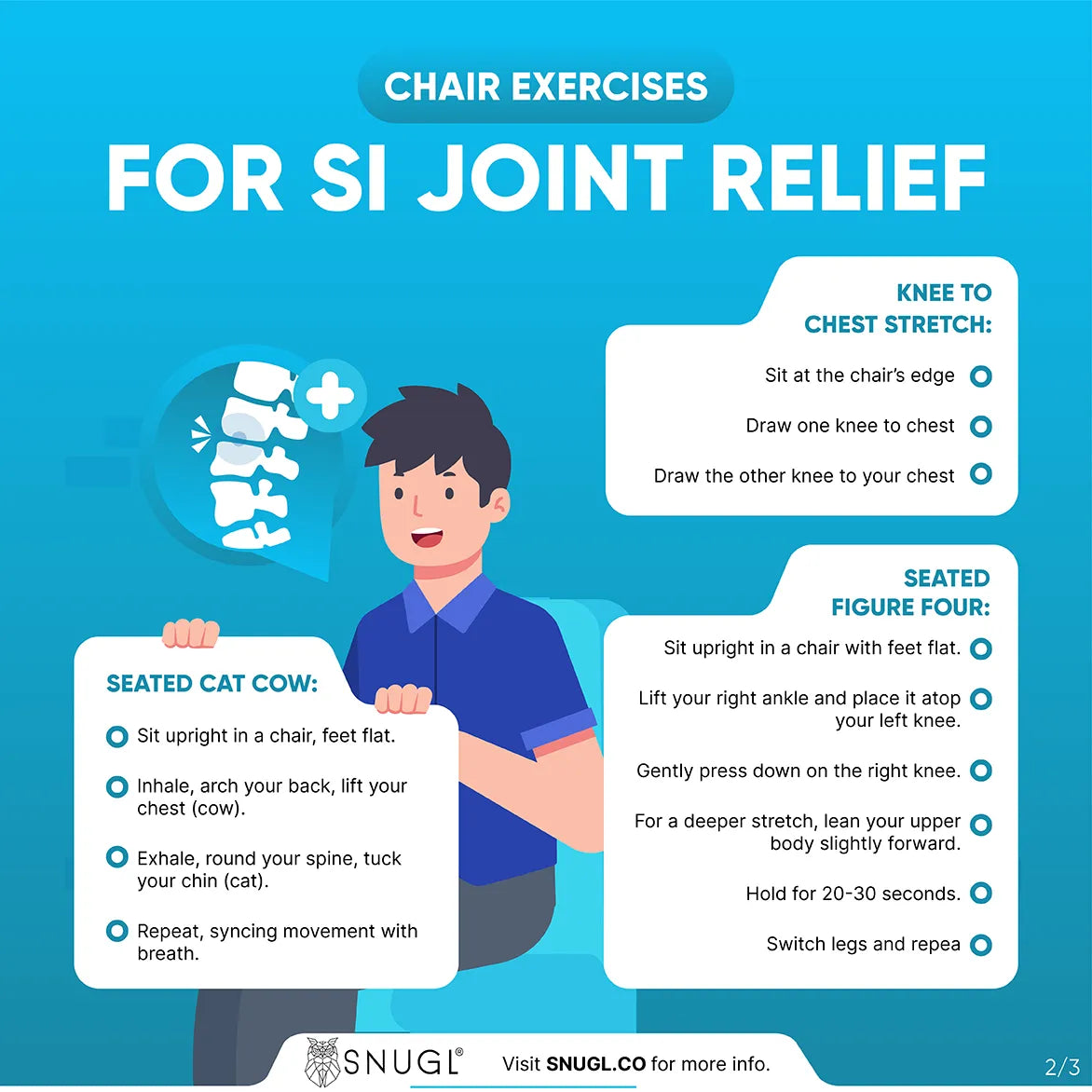Sacroiliac joint pain makes everyday tasks tougher than they need to be. Whether it's sitting at your desk or anything else.
The good news is that, with the right tactics, you can find both relief and comfort.
Whether your situation is chronic or a temporary setback, read on for help. Because knowing the right body alignment to balance your spine can make a world of difference.
Reclaim control over your discomfort and enhance your general well-being with a few small adjustments.
What Is SI Joint Pain?
Imagine your spine as a pile of blocks, and each of these blocks is a vertebra. Just at the end of your spine, where it attaches to your pelvis, there's a small joint called the sacroiliac (SI) joint.
This joint is made by the union of the triangular bone at the bottom of your spine (sacrum) and the ilium bone of your pelvic girdle.
Think of it as a small bridge linking your backbone and your hips.
The SI joint doesn't have much mobility. But it's essential for supporting your upper body and allowing just the right amount of movement between your pelvis and spine.
SI Joint Pain: The Scoop
So, how does SI joint pain happen? Well, occasionally things can get unsteady in the SI joint.
The muscles and ligaments around it might get inflamed or irritated, causing distress or discomfort.
This can occur due to various reasons like:
- Pregnancy
- Injury
- Wear and tear
- Aging
When this joint isn't in good shape, it can lead to pain, especially when you sit down.
What Happens Inside Your Body
Now let's discuss the mechanisms in simple words. When you feel SI joint pain, it's like your systems are displaying a gesture that something's not right.
It's your body's warning indicator, informing you that the SI joint isn't as comfortable and smooth as it should be.
This distress can span from a mild ache to a sharp, acute pain in your buttocks or lower back. Here's a short explanation of the biological processes happening inside your body:
Body misalignment
Sometimes, the joint can get a bit uneven, askew or asymmetrical. This can happen when the connective tissue including the ligaments and tendons that hold everything together aren't functioning properly.
Soft Tissue Inflammation
The connective tissues supporting the joint might become irritated or inflamed due to infection, inflammation or injury, causing discomfort and pain.
Nerve Sensitivity
The nerve fibres in the vicinity of the SI joint can become more receptive or sensitive to noxious stimuli when the joint balance isn’t right.
This can lead to pain radiating into your groin or down your legs.
Muscles Stress
When the SI joint isn't functioning efficiently, it can put additional stress on the soft tissues around it as they try to counterbalance the discomfort-causing elements.
Why It Matters for Sitting Comfortably
Now, let's examine why SI joint discomfort can have an impact on your ability to sit comfortably.
You know that irritating sensation when you're trying to find the comfortable spot on a chair, but no matter how you move or adjust from side to side, you just can't find it?
That's what pelvic joint pain can do.
When the joint isn't in the right form, sitting can put additional pressure on it, making it highly uncomfortable.
Imagine trying to sit with small stones under your pelvis or hip – you'd keep squirming and shifting, right?
That's how SI joint pain can make sitting a real test. You could find yourself frequently adjusting your seat position, trying to find relief.
And if you're sedentary for extended periods, like during a road trip or at work, this uneasiness can start to rub on you.
Practical Tips On How To Sit Properly
Whether you're reading, working, or just relaxing, proper sitting techniques and good posture impact your productivity. Sitting right also affects how you feel generally at work or just relaxing on a chair.
Here are some practical tips that I share with my patients when working at our tertiary care hospital.
Posture is the Key
Keeping good posture while sitting can guard you from a lot of SI joint and other pain. Here's how to do it.
- Sit up straight: Support your back with the your chair's backrest. Imagine a string drawing you gently upwards from the top of your head.
- Relax your shoulders: Let your shoulders rest naturally, not curved up or forced back.
- Don't slouch: Try to not sink into your chair – this can cause tension in your lower back.
Chair, Table and Desks Matter
Picking the right furniture can make a huge difference.
- Chair with support: Choose a chair that offers decent lumbar support. It must have a curve that fits the natural curve of your back. If not, a lumbar pillow can help.
- Knees and hips: Your knees must be at a 90-degree angle with your hips. Adjust your chair height or use a cushion or pillow if needed.
- Feet on the ground: Make sure your feet are flat on the floor. If they don't reach, consider using a footrest.
- Desk height: Make sure your desk or table is at the correct height for your posture. Your arms should rest at ease, making a 90-degree angle at your elbows.

Cushions and Pillows for Extra Comfort
Sometimes a little extra support goes a long way.
- Lumbar pillows: Use a small cushion or lumbar pillow to support your lower back's natural curve.
- Neck pillows: These can help maintain proper alignment and support for your neck and upper back. A travel pillow can be helpful if your chair has a headrest but no pillow for the neck.
- Seat cushions: If your chair is a bit hard, a coccyx cushion can provide extra padding and comfort.
Take Breaks and Move
Even with a perfect posture, sitting for long periods isn't good for your body. Consider these tips.
- Stretch it out: Stretch your arms, shoulders, and neck to release any tension.
- Stand up: Try to stand up and move around for a few minutes every hour.
- Micro movements: Even while sitting, make small movements like shifting your weight from side to side or wiggling your toes.
Listen to Your Body
Your body knows what it needs and will often tell you, so pay attention.
- Change positions: Shift your position now and then. Cross your legs, change your hand placement, or lean back slightly.
- Discomfort signals: If you start feeling uncomfortable, it's time to adjust your posture or take a short break.
Screen and Keyboard Setup
If you're working on a computer, your setup matters. Always experiment, but here are a couple of good rules to stick to.
- Arm position: Keep your elbows close to your body and your wrists straight while typing.
- Eye level: Adjust your screen so that the top of it is at or just below eye level. This prevents straining your neck.
Stay Hydrated and Stay Active
I'm a doctor so you'll forgive me for sharing the same thing your doctor probably tells you.
- Stay active: Consistent exercise can help reinforce your muscles and develop your overall posture.
- Hydration: Drink enough water all through the day. Good hydration supports your joints and muscles.

Driving Tips For A Happy Spine And Joints
Sitting in your comfy car may seem relaxing, but your body deserves some extra care when you are travelling long distances. Here's how you can make those long drives cosy and pain-free.
Adjust Your Seat
Your car seat is one of the key elements in making your car rides comfortable.
- Seat height: Keep your hips at level or marginally higher than your knees. This helps your backbone stay balanced and distributes the weight evenly.
- Backrest angle: Tilt the backrest slightly back, around 100-120 degrees as per your comfort, to support the natural curve of your spine.
Take Mini Breaks
Long drives need a lot of movement if you want to minimise the pain after all those ours of sitting.
- Micro adjustments: Shift your weight from one buttock to the other and wiggle your toes while driving.
- Stretch pit stops: Pull over every hour or so. Stretch your arms, legs, and back for a minute.
Hands-on the Wheel, Eyes on the Road
Be mindful of your posture and keep it in check.
- Seat distance: Your elbows should only be slightly bent when holding the wheel.
- Hand position: Hold the steering wheel at 3 and 9 o'clock, or 4 and 8 o'clock. This avoids putting extra strain on your shoulders.
If you do spent a lot of time in your car, you can find my full article on driving with back pain here.
Lumbar Support
Your lower back deserves some keen attention. If your car seat doesn’t support your lower back, use a small cushion or pillow to keep your lower back comfortable.
Use Supportive Accessories
Extra tools and equipment are necessary for extra comfort:
- Headrest pillow: If you're not in the driver's seat, consider a car headrest pillow to keep your head balanced.
- Seat cushion: Use a cushion to add a layer of cosiness and support.
Stay Hydrated
Your body needs water at all times. Sip water during the ride. Staying hydrated helps your muscles and joints function smoothly. It's also great for focus and concentration while you drive.
Give Space To Your Knees
Knees deserve to breathe too.
Make enough room for your knees without straining the rest of your legs while you sit. The road journey is just as significant as the destination when it comes to managing that pain.
These guidelines aren't just for people with SI joint pain – they're for every person looking forward to enjoying their ride without discomfort.
So, next time you are on the road, make use of these tips and give your body the attention it deserves.
How To Heal SI Joint Pain: Comfort Boosters And Lifestyle Strategies
Recovery from SI joint pain takes time, but there are lifestyle strategies that can speed things up and make you more relaxed.
Move, But Move Smart
Staying active is the key to healing SI joint pain. Make use of these pointers:
Avoid jarring movements
Stay clear of high-impact workouts that might aggravate your pain. That includes lifting weights and running. Anything that involves sudden, moderate-severe pressure on your joints won't help you heal fast.
Swimming and low-impact exercise
Instead, choose activities such as walking, swimming, or gentle yoga. These can effectively ease the strain on your joints.
Swimming especially has a great track recording of helping back and joint pain. So check out the link above for more info on how swimming helps with pain.

Mind Your Diet
Your eating habits and the nutritive value of the food matter. These two tips are especially relevant for your joints.
- Omega-3 fatty acids: They're efficient fighters against inflammation found in flaxseeds and fish among other natural foods.
- Other Anti-inflammatory foods: Add nutritious foods like berries, salmon, and leafy greens. The're effective against soft tissue inflammation.
Ice and Heat Therapy
Both ice and heat therapy works like magic to soothe pain of many kinds and can help SI joint pain, too.
- Ice: Put on ice for 15-20 minutes to decrease inflammation and reduce pain.
- Heat: After the first few days, switch to heat to boost blood flow and relax muscles. Deep heat rubs can work well for pain.
Listen to Your Body
Your body gives you hints about the internal environment all the time.
- Listen to it: Modify activities: Adjust your activities to avoid movements that trigger pain.
- Rest when needed: Give yourself a break if your pain relapses.
Stress Less
Practises like meditation and deep breathing exercises can help reduce stress, which can provide relief from the psychological aspect of pain.
Mind Your Posture
Whether standing, sitting at a desk, or walking, always look after your posture:
- Standing tall: Avoid slouching at all times – it can strain your lower back and cause permanent changes in the soft tissues surrounding the joint.
- Sit mindfully at your desk: Even when you are bingeing on your best shows, keep your posture in check.
Patience is a Virtue
It’s essential to remember that healing doesn't happen overnight.
- Consistency: Stick to your lifestyle changes and treatment plan for best results.
- Healing timeline: SI joint pain can take some weeks to months to completely heal.
Seek Professional Help
Occasionally, a visit to a health professional is necessary for a proper in-person evaluation and management.
- Physical therapy: Exercises that help stabilise your SI joint and pain-relieving procedures are offered.
- Chiropractic care: Some people find respite through spine balancing and adjustments. Every person is different so it’s important to explore and see what works best for you.
The Bottomline: Experts’ Advice
My best advice as a medical professional for sitting with SI joint pain is to focus on maximising comfort and keeping a good posture.
Use additional pillows and cushions to maintain your spine's natural curve without added strain.
To reduce the impact on the SI joint, use chairs and car seats with proper lumbar support. Take time to stretch and move around, particularly during long rides.
To avoid further pain, respond to the hints and signals from your body and make the appropriate posture adjustments.
You can significantly boost your comfort and decrease the effect of SI joint pain while sitting if you follow this advice.
All the best for your long drives and work endeavours.
References:
1. Healthline. What’s the Best Sitting Position with Sacroiliac Joint Pain? https://www.healthline.com/health/how-to-sit-with-si-joint-pain
2. Spine Health. Sitting and Sleeping Comfortably with SI Joint Pain. https://www.spine-health.com/blog/sitting-and-sleeping-comfortably-si-joint-pain

